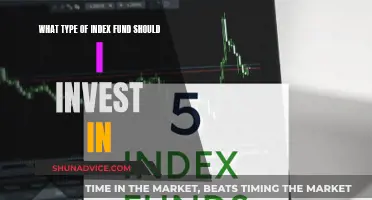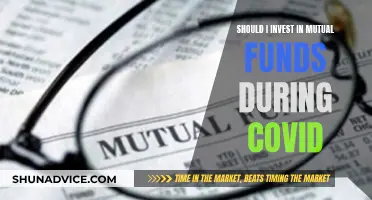
Index funds are a popular investment option due to their low fees, diversification, and performance. They are investment portfolios that aim to track a specific financial market, usually the stock market, and often have low minimum investment requirements, making them accessible to a wide range of investors.
In Australia, there are two common ways to invest in index funds: through a managed fund or an exchange-traded fund (ETF). A managed fund involves investing directly with a fund provider, often requiring a higher minimum investment, while an ETF can be purchased through an online stock broker or share trading platform with lower minimum investments.
When choosing an index fund, it is important to consider factors such as fees, performance, and investment strategy. Additionally, understanding your financial goals, risk tolerance, and time horizon is crucial in determining the right index fund for your needs.
By investing in an index fund, you can gain exposure to a diversified range of assets, making it a convenient way to build a well-rounded investment portfolio.
| Characteristics | Values |
|---|---|
| Definition | Investment portfolio that aims to track a market index |
| Examples | S&P 500, ASX200, ASX300, MSCI World ex-Australia index, Nasdaq-100 |
| Investment types | Stocks, bonds, commodities, currencies, biotech, healthcare, mining, technology, financial, IT, gold, oil, local and global bonds |
| Advantages | Low fees, diversification, performance, ease of trade, tax-efficient, cost-effective, simplicity, accessibility, transparency |
| Disadvantages | Market risk, limited upside, lack of flexibility, tracking error, inflation risk |
| Minimum investment | $1, $10, $500, $5,000, $10,000, $100,000 |
| Brokerage fee | $0, 0.03%, 0.1% - 0.3%, 0.5% |
| Management fee | 0.03%, 0.04%, 0.1%, 0.13%, 0.2%, 0.3% |
What You'll Learn

Understanding index funds
Index funds are a type of investment portfolio that aims to track a market index, such as the S&P 500 or the ASX200. They are a form of passive investing, where fund managers maintain the asset allocation by tracking an index, rather than actively picking individual stocks. This passive management style results in lower costs for investors.
Index funds pool money from many investors to buy a diversified portfolio of stocks, bonds or other assets. Each share of an index fund represents an investor's proportional ownership of the fund's portfolio and the income it generates.
Index funds are typically associated with low minimum investment requirements and high liquidity. They are considered a good choice for retail and professional investors alike, as they offer instant diversification at a low cost.
There are two main types of index funds:
- Exchange-traded funds (ETFs): These are the most common type of index fund in Australia. ETFs are traded on a stock exchange, like shares, and often have low management fees. However, they attract brokerage costs on each trade.
- Managed funds/mutual funds: These are traded off-market through fund issuers and don't usually attract a fee for buying or selling units. They generally require a higher minimum investment and have higher management fees.
When choosing an index fund, it's important to consider the fund's management fees, as these can impact your overall returns. The most common fee is the management expense ratio (MER), which is expressed as a percentage of your investment.
Index funds can be further categorised based on the types of indices they track:
- Broad-market index funds: These are standard index funds that hold a collection of stocks from a major stock market index, such as the ASX 200 or S&P 500. They are considered relatively safer options due to their diversification across the entire market.
- Sector-based index funds: These funds track a specific sector of the market, such as healthcare, technology, or mining.
- Market-cap index funds: These funds hold a collection of companies based on their size or market capitalisation.
- Smart-beta index funds: These funds track an index of stocks based on specific factors such as volatility, dividends, or balance sheet strength.
- Commodity index funds: These funds don't track stocks but instead focus on commodity or currency prices, like crude oil futures. They are much riskier than broad-stock market index funds.
- Bond index funds: Bond index funds hold a collection of bonds that can be local, global, corporate, or government-based, depending on the index.
When investing in index funds, it's important to consider your investment strategy, risk tolerance, and time horizon. Additionally, diversification is key to reducing risk and enhancing long-term returns.
In summary, index funds offer a simple and cost-effective way to gain exposure to a diversified range of assets. They are a popular choice for investors seeking a more passive approach to investing, allowing them to benefit from the overall performance of the market rather than relying on individual stock picks.
Mutual Funds: Diversify Your Portfolio, Maximize Returns
You may want to see also

Choosing a brokerage platform
There are at least 40 online brokers available in Australia as of 2024. To find the best broker for you, select one with low brokerage fees, no ongoing account fees and features that suit your needs best. Here are some features to consider when choosing your broker:
Brokerage fees
This is the fee you pay every time you buy or sell stocks or ETF units. If you plan to invest regularly in your index fund, you'll want to find a broker with a lower commission/brokerage fee.
ETF screeners
Some brokers offer search tools that help you find ETFs depending on a set of criteria. For instance, if you wanted to find an ETF of major US tech stocks, you can use a screener to narrow down your choices.
Dividend reinvestment
If you decide you want any index fund dividends reinvested back into the fund automatically, make sure your broker has this as an option.
Access to the Australian Securities Exchange (ASX)
If you plan to invest in a local index fund, you'll want to find a broker that offers access to the ASX.
Inactivity fees
Some brokers charge inactivity fees if you don't make a certain number of trades per year. These brokers are typically better suited to active traders rather than long-term investors.
It's worth noting that some online trading platforms offer $0 brokerage on ETF purchase orders, meaning you can add funds to your ETF as often as you like without paying additional trade fees.
Chit Funds: Smart Investment Strategies for Beginners
You may want to see also

Selecting an index fund
There are a few ways to access an index fund. One way is to invest directly in an index fund through a provider. However, if you want to be able to choose from multiple funds and possibly buy Australian shares as well, you'll need to open a brokerage account with a reliable investment platform that offers access to the ASX and US markets.
When it comes to selecting an index fund, there are several factors to consider. Here are some key considerations:
- Investment Goals: Before investing, it's important to have a clear understanding of your investment goals and risk tolerance. Are you investing for the long term or looking for short-term gains? Do you want capital appreciation or focus on income generation? Knowing your investment goals will help you choose an index fund that aligns with your objectives.
- Index Type: Index funds can track various indices, such as broad-market indices (e.g., ASX 200, S&P 500), sector-based indices (e.g., healthcare, technology), market-cap indices (e.g., small-cap, large-cap), or commodity indices. Choose an index that matches your investment strategy and risk appetite.
- Fees: Index funds typically charge management fees, which can vary between funds. Look for funds with low management expense ratios (MERs) to minimise fees. Also, consider other fees such as brokerage fees, transaction costs, and dividend reinvestment fees.
- Performance and Track Record: Evaluate the historical performance of the index fund and how closely it has tracked its underlying index. Compare the fund's returns with similar funds and the overall market. Be sure to review the fund's performance over different time periods to understand its consistency.
- Fund Size and Liquidity: Consider the size and liquidity of the index fund. Larger funds may offer more stability, while smaller funds might provide more niche investment opportunities. Assess the fund's liquidity to ensure you can easily buy and sell units when needed.
- Fund Manager: Research the fund manager's reputation and track record. Evaluate their investment strategy, performance across different market conditions, and how they handle fund administration and adjustments.
- Diversification: One of the key advantages of index funds is diversification. Look at the underlying assets of the fund to ensure it provides adequate diversification across different sectors, industries, and markets. Diversification can help reduce risk and enhance long-term returns.
- Dividends: Some index funds pay dividends, while others focus on capital appreciation. If dividends are important to you, check the fund's dividend policy, distribution frequency, and historical dividend yield.
- Risk Profile: Different index funds carry varying levels of risk. Consider your risk tolerance and choose a fund that aligns with your comfort level. Remember that higher-risk funds may offer the potential for higher returns but also carry a greater possibility of loss.
- Minimum Investment: Index funds have varying minimum investment requirements. Be sure to check the minimum investment amount required for the fund you're considering. If you have a limited budget, look for funds with lower minimum investments or consider micro-investing options.
Remember to do your research and compare multiple index funds before making a decision. Carefully review the fund's product disclosure statement (PDS) and seek advice from a financial professional if needed to ensure the fund aligns with your investment goals and risk tolerance.
Mutual Funds Philippines: Best Time to Invest
You may want to see also

Buying units
The simplest and cheapest way to invest in an index fund is through an exchange-traded fund (ETF). To invest in an ETF, you'll need to open an account with an online stockbroker or share trading platform.
There are at least 40 online brokers available in Australia as of 2024. To find the best broker for you, select one with low brokerage fees, no ongoing account fees and features that suit your needs best.
- Brokerage fees: This is the fee you pay every time you buy or sell stocks or ETF units. If you plan to invest regularly in your index fund, you'll want to find a broker with a lower commission/brokerage fee.
- ETF screeners: Some brokers offer search tools to help you find ETFs based on a set of criteria.
- Dividend reinvestment: If you decide you want any index fund dividends reinvested back into the fund automatically, make sure your broker offers this option.
- Access to the Australian Securities Exchange (ASX): If you plan to invest in a local index fund, you'll want a broker that offers access to the ASX.
- Inactivity fees: Some brokers charge inactivity fees if you don't make a certain number of trades per year. These brokers are better suited to active traders.
It's worth noting that some online trading platforms offer $0 brokerage on ETF purchase orders, meaning you can add funds to your ETF without paying additional trade fees.
When you've found a broker that suits your needs, you'll need to search for your ETF within the platform. The easiest way to do this is by using the fund's ticker code—a 3- or 4-letter unique code that every ETF and stock has.
You'll then need to purchase your ETF units using either a "market order" or a "limit order". A market order buys the units for the current rate, while a limit order lets you set a specific price to ensure you don't purchase during a period of unexpected volatility.
Technically, when you buy an index fund, you're buying units in that fund. These are similar to stocks but, when you buy a unit of an index fund or ETF, you're investing in a whole collection of stocks in one go.
Dividend strategy
Some index funds in Australia pay out dividends. If you've selected a dividend-paying index fund, you'll need to decide whether you want the dividends paid into your account or reinvested.
Index fund and ETF dividends are automatically paid into your selected bank account. If you'd prefer to reinvest, you'll need to sign up for a dividend reinvestment plan (DRP).
To participate in the DRP, you need to complete a DRP instruction form and return it to your ETF's share registry.
There are several share registries in Australia. You'll find your ETF's share registry on its website or in the product disclosure statement (PDS). When you invest in the ETF, you should also receive a statement in the mail from the share registry with contact details.
However, this will only work if your stockbroker offers CHESS-sponsored shares and ETFs. If you use a custody-model broker, you'll need to check whether the platform offers a DRP option.
International Equity Mutual Funds: Diversify and Grow Your Wealth
You may want to see also

Tracking performance
Tracking the performance of your index fund is an important step in the investment process. Index fund investing is typically a long-term strategy, so patience is key.
Index funds are considered a safer alternative to direct stock market investing because indices are generally less volatile than individual stocks. However, it's important to remember that the value of your index fund will still fluctuate with the market.
If you plan to hold your Australian index fund for many years, try not to check on its performance every day. Instead, think about taking stock every few months or so.
When it's time to sell, you'll follow a similar process as when you purchased the index fund units. You'll need to sign in to your stockbroker, navigate to your index fund, and select either a "market" or "limit" sell order.
Index funds are proven to have outperformed many other kinds of investments over the years. In 2008, Warren Buffett, one of the world's most successful investors, made a $1 million bet that a bundle of actively managed funds would be worse off than the S&P 500 over ten years. He argued that if a fund mimicked a major index, it would deliver better returns than a fund actively managed by professionals. Buffett's ultimately successful wager showed that net of fees, an S&P 500 index fund would outperform a hand-picked portfolio.
Although major indices fluctuate from year to year, they usually rise over the long term. For example, the ASX 200 index fell by more than 15% during the 2008 global financial crisis. But even if you had invested in the index fund just before that, you'd still be in a better financial position today than if you hadn't invested at all.
Ultimately, index funds have a well-earned reputation as an accessible, low-cost way for normal investors to get exposure to the stock market.
Invest Wisely: Kotak Select Focus Fund Guide
You may want to see also
Frequently asked questions
An index fund is an investment portfolio that aims to track a specific financial market, such as the stock market. Index funds pool money from investors to create a fund that mimics a particular asset, such as an index or bonds.
Index funds are a good long-term investment option. They are popular due to their low fees, diversification, and performance. They are also easy to invest in for beginners.
You can buy index funds in Australia by signing up for an online stock broker and purchasing units in an exchange-traded fund (ETF). You can also apply to invest directly through the fund manager.
You can invest in index funds with as little as $1 by using micro-investing apps or standard trading platforms. However, if you invest directly through a fund manager, the minimum investment could be between $5,000 and $100,000.
Like any investment, there is a risk of losing money. Index funds are not a short-term investment option and are best suited for long-term investment strategies. Additionally, not all assets in index funds are safe, and some funds track volatile global markets.







